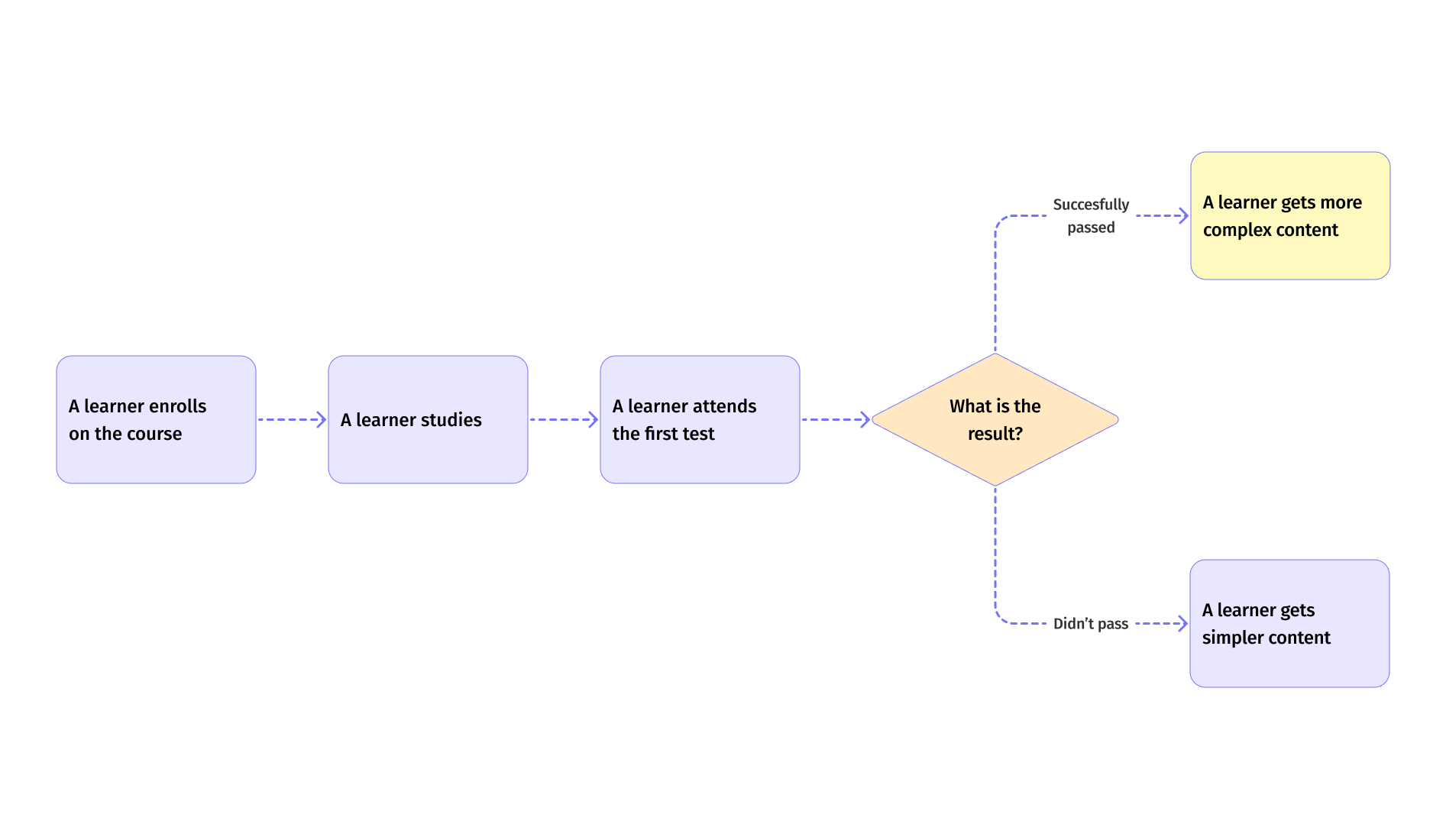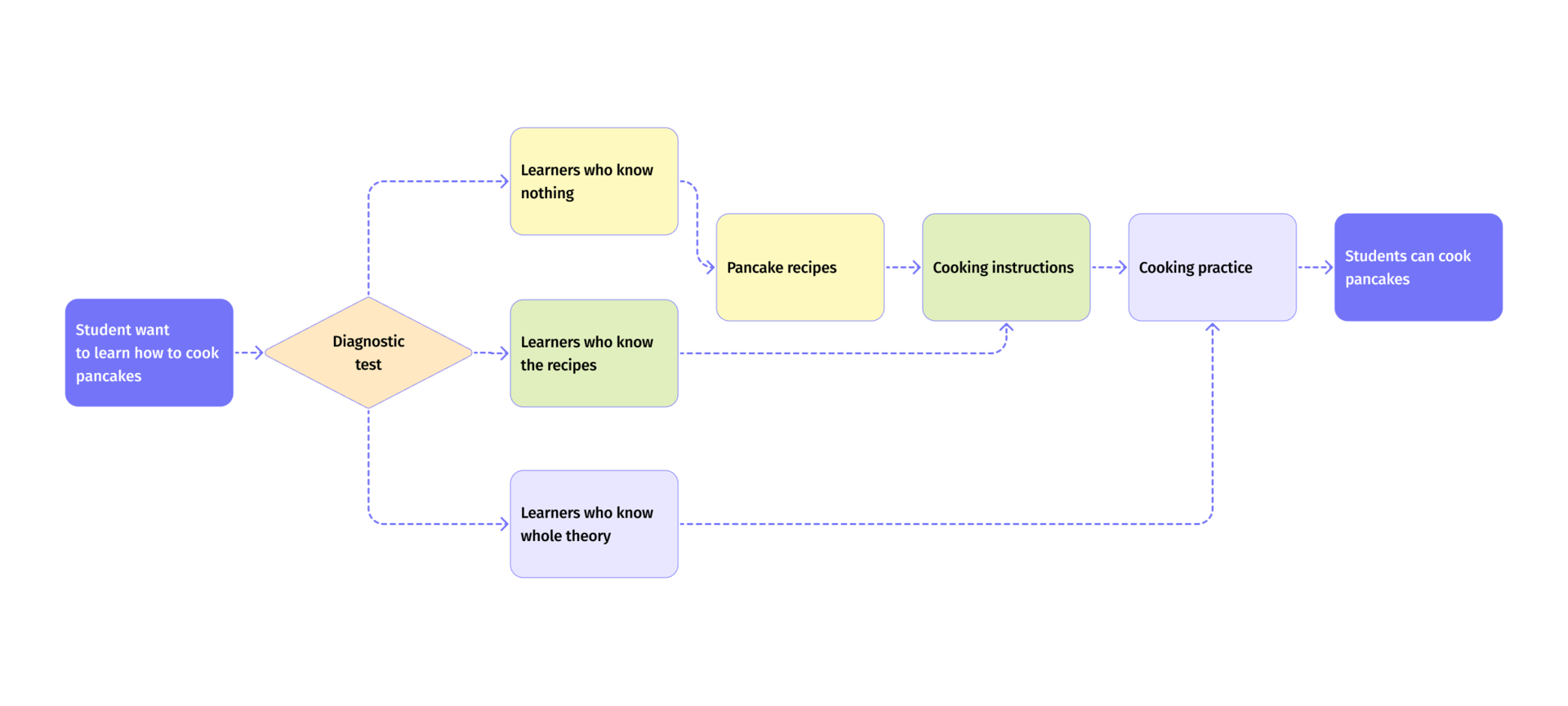
A Brief Introduction To Adaptive Learning
When you think of education, you might picture classrooms or structured corporate learning programs. Although these traditional training methods are common, they usually fall short of addressing the unique needs of every learner. Let’s look at one example.
Imagine you bought a leadership course. In your group study middle-level managers, a CEO of a middle-size company, and you, an experienced IT director. A regular course doesn’t suit everyone; some might find the material boring, while others struggle to keep up.
This mismatch can reduce the overall effectiveness of the course and ruin the whole experience. Personalized learning helps eliminate these issues.
Key Points
- What are personalized learning tracks?
- What’s the difference between personal tracks and adaptive learning?
- How does adaptive learning work?
- What are the benefits?
- How can you create adaptive learning?
- Adaptive learning software?
What Is Personalized Learning?
Everyone has unique, preferred learning methods and different learning paces. The concept of personalized learning is built on this principle. Each learner has a customized educational plan that aligns with their needs and learning preferences. But does it work?
A study conducted by RAND in 2015 found that 11,000 students from 62 schools that used personalized learning techniques showed greater improvements in math and reading than students from traditional schools. The research suggested that the more time students spend using these personalized approaches, the better their progress tends to be.
There are two main approaches to personalized learning:
- Personal education tracks
- Adaptive learning
What’s The Difference Between Personal Tracks And Adaptive Courses?
Personal education tracks are designed by either learners or educational specialists. These tracks consist of courses that focus on a subject you wish to learn. For example, one course may have three difficulty levels to accommodate everyone: beginner, intermediate, and expert. This way, learners can choose a track that best suits their experience and skill level.
Adaptive learning is different. This is a flexible learning approach that adjusts based on each learner’s progress. For those who quickly grasp the material and pass tests, the program increases the difficulty to keep them engaged and help them achieve even better outcomes. Similarly, for those who are having a tough time, the program identifies their needs and adapts the learning experience to support them. Let’s look at the learners’ journey in the adaptive course.

How Does Adaptive Learning Work?
Adaptive learning is part of interactive learning, which addresses individuals’ needs through learning pathways, effective feedback, and supplemental resources rather than a one-size-fits-all curriculum (Kurt, 2021).
But let’s keep it simple. Adaptive courses modify their complexity and content based on students’ behaviors and needs. A learning platform gathers and evaluates data from every student to decide what content they will see next. Those types of courses include adaptive sequences of content and assessments. The platform changes what students see next based on their progress during the course.
What Are The Benefits?
Let’s look at the numbers first. The outcomes of implementing adaptive learning in higher educational institutes are:
- The rate of students passing exams increased by 18%
- Withdrawals from math courses dropped by 47%
- In an economics course, the rate of students passing exams increased by 27%
These findings reveal that adaptive learning helps keep students interested and leads to better learning results. Additionally, adaptive learning helps create the flow effect: the tasks are just complex enough to keep students interested and motivated to resolve them (Mihály Csíkszentmihályi). This approach is heavily used in video games to involve gamers in gameplay.
Adaptive learning is a helpful teaching method, but it doesn’t solve every problem. It’s important to also consider how to keep learners motivated and ensure they can use what they’ve learned. Still, this method can make it easier for students to explore important concepts and focus on what really matters.
How Can You Create An Adaptive Course?
The cost of adaptive learning has always been an issue. Creating a unique learning experience for each student is not cheap. Quite recently, the only way to take adaptive courses was by hiring a personal tutor or studying in tiny groups. Organizing this form of education in schools or the corporate environment isn’t practical and is resource-intensive.
Luckily, technological advancements make this process more affordable and accessible to implement. The main difference is that adaptive learning can now be automated and done online. That means 40% to 60% less time to learn new skills and millions of dollars saved on implementing learning.
Next, I’ll tell you about creating an adaptive course. If you need to refresh your knowledge of how to do a course in general, I suggest you read this article first. The reason is that designing adaptive courses may be a bit tricky. Here are the main steps:
1. Create Learning Paths
You need to design different learning paths based on learners’ behaviors and levels of knowledge. These paths show you how different audiences can achieve the results you need. So, you must study your audience and create a learning map.
2. Create Personalized Assessments And Feedback
The learning path will be determined by the student’s progress on the course. So, assessments are essential for adaptive learning. You need to create tasks and tests that will show you the level of the student’s knowledge and areas they need to improve to achieve the overall course’s outcomes.
3. Create Small Educational Content Units
Develop objective-based short lessons connected to overall learning objectives (Cavanagh et al., 2020, p. 178). This helps you construct the patterns of learning. Every adaptive track will include the units students need to achieve the required outcome.
Let’s look at the “pancake example.”

Every learner now receives only the relevant information. To create these adaptive courses, it’s important to understand both the learners and the goals of the course. This means that designing these courses takes more time than traditional ones.
Using Adaptive Learning Software To Create An Adaptive Course
You need software and tools to collect and analyze data to create adaptive learning. Several Learning Management Systems (LMSs) can help you create and automate this process. Let’s discuss general recommendations for choosing the suitable LMS.
1. Determine The Amount Of Money You Are Willing To Spend
Budgeting is a critical step. Determine how much money you are willing to spend on an LMS. Keep in mind that price and quality are not always correlated.
2. Study Your Audience
Before searching the LMS, it is crucial to describe your learner personas. Examine the ways in which they typically learn. You need to answer a few questions:
- How much time can learners spend studying?
- Where do they usually study? When working out, walking a dog, or riding the bus to work?
- What format of educational material do they like the most? Is it books, or videos, or podcasts?
Don’t ask questions about the future, such as “Would you do that?” or “What would you like more?” Only ask questions about the present and past. There’s often a gap between what people desire and what they actually use.
3. Choose The Course’s Format
After setting a budget, it’s time to consider the format. What type of education do you plan? Articulate the vision for your course in a way that aligns with your budget and effectively addresses the needs of your audience.
4. Identify The Data You Need To Collect
Start by defining your objectives. Each course should target a specific goal. Corporate training, for example, aims to improve business metrics, such as the speed of service delivery. Likewise, English courses in schools are designed to help students achieve better results and increase the school’s reputation. It’s crucial to determine the metrics that must be monitored to evaluate the progress toward these goals.
5. Develop A List Of Features Necessary For The Course
When it comes to creating engaging content like videos, articles, and even simulators, choosing the right Learning Management System is crucial. Look for an LMS that supports adaptive learning and offers essential tools to enhance your experience. Features to consider include an intuitive course editor, automated analysis, personalized learning path adjustments, and a data-responsive platform. Always try the demo and explore the product to ensure that LMS suits you.
Resources:
- Kurt, S. 2021. Adaptive learning: What is it, its benefits, and how does it work? Educational Technology.
- Cavanagh, T., B. Chen, R. A. M. Lahcen, and J. Paradiso. 2020. Constructing a design framework and pedagogical approach for adaptive learning in higher education: A practitioner’s perspective. International Review of Research in Open and Distributed Learning 21(1): 173-197.
- Pane, John F., Elizabeth D. Stainer, Matthew D. Baird, and Laura S. Hamilton. Continued Progress: Promising Evidence on Personalized Learning.
Image Credits:
- The images in the body of the article were created/supplied by the author.